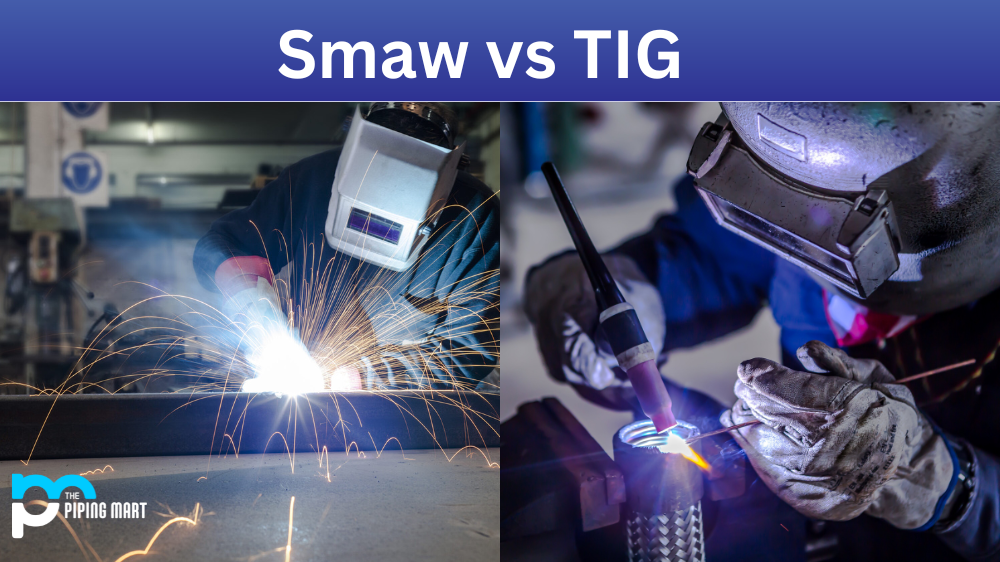When it comes to welding, two of the most commonly used methods are shielded metal arc welding (SMAW) and inert tungsten gas (TIG) welding. Both of these methods have their appropriate uses and can be used to weld various metals. But how do you know which one is right for your project? Let’s take a closer look at the differences between SMAW and TIG welding.
Understanding SMAW
When it comes to SMAW or stick welding, a flux-covered electrode is used to create the weld. This process is simple and does not require additional shielding gas or filler material—just an electric current that runs through the electrode, creating an arc between it and the workpiece. Stick welding is excellent for outdoor projects since the wind won’t blow away any shielding gases, and it’s also great if you need to make quick repairs since it’s so easy to use. However, it isn’t as accurate or precise as other methods like TIG welding. Smaw is a welding process that uses an electrode to create an arc between the metal and the electrode. The electrode is made of consumable material, such as carbon, that is melted by the arc’s heat and deposited onto the metal. Smaw is typically used for welding thicker materials, as it can create a stronger weld than other welding processes.
Understanding TIG Welding
In contrast, TIG welding requires an electrode made from tungsten and a separate filler rod made from the same material as the welded workpiece. This method also relies on an electric current that passes through both components simultaneously. At the same time, shielding gas surrounds them—this helps keep oxygen away from the weld area and prevents oxidation. TIG welding takes more time than SMAW but produces cleaner, more visually appealing results with less slag buildup around the joint space. It’s also more precise than stick welding since operators have more control over speed and angle changes when guiding the torch around tight angles or curves in a project piece during fabrication. Tig is a welding process that uses an electrode to create an arc between the metal and the electrode. However, unlike smaw, the electrode in tig welding is not consumable. Tig welding can be used for thin and thick materials but is most commonly used for thinner materials. Tig welding can also create a stronger weld than smaw welding.
Advantages of Smaw Welding
One of the advantages of smaw welding is that it can be used to weld thicker materials. Additionally, smaw welding can create a stronger weld than tig welding. Another advantage of smaw welding is that it is less likely to cause warping or distortion in the welded material.
Advantages of Tig Welding
One of the advantages of tig welding is that it can be used for both thin and thick materials. Additionally, tig welding can create a stronger weld than smaw welding. Another advantage of tig welding is that it produces less heat than smaw welding, which can help to prevent warping or distortion in the welded material.
Disadvantages of Smaw Welding
One of the disadvantages of smaw welding is that it uses a consumable electrode, which means that it can be more expensive than tig welding. Additionally, smaw welding produces more heat than tig welding, which can lead to warping or distortion in the material being welded.
Disadvantages of Tig Welding
One of the disadvantages of tig welding is that it requires more skill than smaw welding. Additionally, tig welding can be more expensive than smaw welding because it uses non-consumable electrodes.
Conclusion:
SMAW and TIG are two very different types of welding processes with distinct advantages depending on the project you’re working on. SMAW may be your best bet if you’re looking for fast, on-the-spot repairs; however, if you need something more precise, TIG might be better suited for your needs. Ultimately, understanding each method’s strengths will help you correctly choose which type of weld is right for your project!

A passionate metal industry expert and blogger. With over 5 years of experience in the field, Palak brings a wealth of knowledge and insight to her writing. Whether discussing the latest trends in the metal industry or sharing tips, she is dedicated to helping others succeed in the metal industry.




